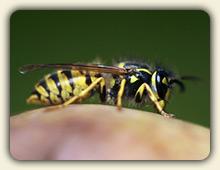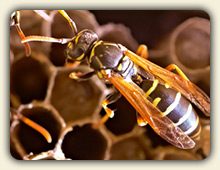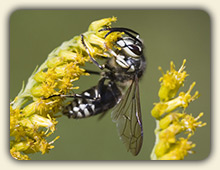Natural Wasp Sting Treatment
Learn safe, natural wasp sting treatment here. Wasp stings are a real hazard, and worth some research. This article details types of wasps, as well as wasp sting treatment, natural remedies, causes, prevention, symptoms and more.
A wasp is just a wasp right?
Here we identify three main wasps that can all impose a painful wasp sting. It's very important to be able to identify the different species of wasps, especial to learn how to prevent wasp stings. By learning more about the different types of wasps you'll discover subtle differences amongst each of them. All of this adds up to an accumulated understanding that will increase your knowledge, awareness and respect of them as you go about spending time in nature.
With so many insects flying around, it's also important to know that bee stings are different from wasp stings. A bee stinger is barbed like a miniature hook. Once injected into the skin, the bee will not be able to withdraw it. When the bee flies off, the stinger is left behind. The stinger will then continue to insert venom after the bee has buzzed away. Hence it's critical to remove the barb without squeezing it before you seek wasp sting treatment. For both bees and wasps, it is only the female that can sting. However a wasp stinger is not barbed and as a result, the wasp can sting repeatedly.
Here is a list of the three different types of wasps, all in the Vespidae family:

Yellowjacket
This wasp is very common. The abdomen of its body is lined with black and yellow stripes. Its' body is broader than its head. It is 1/2 - 5/8 inches in length. They notoriously build nests in the ground and in stumps and logs. They are one of the well-known scavengers of the insect world flying off with people's food from picnics, barbecues and other feasts!

Paper Wasp
The paper wasp is very similar in color to the yellowjacket, with yellow and black stripes. However, this wasp has distinctly long legs, and a more elongated body when compared with a yellowjacket. It is up to 1 1/4 inches in length. They can be found building their paper nests near houses, barns and outbuildings as well as branches on trees and shrubs.

Bald-faced Hornet
This wasp has a wide face, and a black and white (pale yellow) design on it's body with opaque wings. 1/2 - 3/4 inches in length. This unique wasp is well-known for delivering repeated stings. Their large, paper nests are most often built upon branches of trees. You can find them around open fields, lawn areas and forest edges throughout North America.
For more information on wasps and identifying them, I recommend you get a good field guide like Venomous Animals and Poisonous Plants by Steven Foster and Roger Caras. There are many other flying stinging insects out there and it's important you familiarize yourself with them.
Causes of wasp stings
There are many causes for a wasp sting, but it all comes down to disturbing them or their nests. Perhaps you're walking through the forest and unknowingly you step on a wasp ground nest. The impact of your step can disrupt the wasps that are hidden within. Kicking old stumps, shaking branches, pulling plants or moving logs from their nest area are all ways that wasps can feel their home is being threatened. They are experiencing some intrusion or invader whether you intended to be one or not. Loud noises and strong smells can even potentially cause wasp stings.
I remember one hot summer day I left my water bottle open. Without realizing it, a yellowjacket flew in. I didn't see the yellowjacket inside it because my water bottle was made of stainless steel. I picked up my water bottle and began drinking. I felt a zap on my tongue likened to electricity. I realized that a yellowjacket had just stung me on the tongue but fortunately I hadn't swallowed it! It was still floating around in my water bottle. It was the most curious sensation and flavor to taste yellowjacket venom. So sometimes the most basic everyday experiences like drinking water can even cause a wasp sting. Thankfully I'm not allergic to them so I didn't need any wasp sting treatment! Speaking of allergic reactions, this brings us to symptoms of a wasp sting. Read on...
Symptoms of a wasp sting
So you just got stung - ouch! You need to know the various reactions or symptoms that could follow so you know what specific wasp sting treatment that is needed.
First there is the local reaction. The most common localized symptoms you could experience are pain, swelling, tenderness, irritation, itchiness and redness right where the wasp sting is. This could last for a few minutes or more likely, a few hours.
You could experience a systemic allergic reaction which could move through your entire body. This can happen because a person's immune system is incredibly sensitive to the venom. This is one degree less common than a localized reaction to a wasp sting. The symptoms here look like difficulty breathing, rashes or spots, swelling in the mouth or throat and difficulty speaking. All of this can show up within an hour of the wasp sting. There is so much more that could be said here but the most important thing is to get wasp sting treatment immediately. Some people are allergic and can go into anaphylactic shock. In this case, the wasp sting treatment called for would be an epi-pen, which is a shot for treating this severe allergic reaction.
A toxic reaction could surface as a result of a wasp sting. These reactions usually occur with multiple stings where a larger amount of venom comes into the body. Watch for dizziness, nausea, headache, fainting, fever and vomiting. You could even have convulsions. Wasp venom can be an incredibly strong shot to the immune system so watch carefully what comes as a result of a wasp sting.
Lastly, there is a delayed reaction which is not very common at all. It can transpire days or even weeks after the wasp sting happened. Symptoms can range from itching, rashes, and fever to brain, blood vessels, nerves, or kidney inflammation and blood clotting.
Be mindful of the sting and watch for infections that can occur in wasp stings. If an infection sets in, there can be an increasing of pain, swelling, redness and drainage of pus on the wasp sting site that continues for several days. If you can get swift at identifying the symptoms of a wasp sting you'll be that much quicker at getting the appropriate wasp sting treatment.
Wasp sting prevention
The best prevention for a wasp sting is awareness. Awareness of wasps and of where they live. Knowing their habitat, their behaviors and how they move and get around. Awareness of what they eat, when they are active and identifying the zones where they hang out the most. These insects are very spirited life forms that have a whole identity and life style just like you and me. Getting to know them through observation and research will actually offer you the opportunity to see how fascinating their lives really are. As well, you gain the potential for this relationship with them to be transformed from foe to friend.
From awareness comes a sensitivity that develops over time by actually being out there and watching them in action. It's important not to hang out right around them but to observe them from a distance in order to keep yourself safe from harm. Watching closely to see what they're up to gives you the leading edge on steering clear of them meanwhile respecting their space.
From the sensitivity that develops over time comes a greater understanding, respect and appreciation for these small yet powerful little creatures. Just like everything in nature, wasps are a fascinating and unique expression of life. Slow down, and ponder the wasps ability to produce a nest of such symmetrical beauty. Or their amazingly complex social structure. Or the simple beauty of flight. What appreciation can you find for a wasp? What does a wasp have to teach you? This is an especially good question to ask when you get stung, for nature acts as a mirror. It's so easy to seek wasp sting treatment and then forget that you ever got stung. What is the wasp telling you? How can you apply this to other areas of your life?
Through curiosity, respect, humility, and a willingness to learn from nature, you may just develop a real fondness for wasps.
Wasp sting treatment
Just as we are given the opportunity to wake up and connect with our surroundings in order to be safe with wasps, we need to be prepared with wasp sting treatment should we ever get stung.
Natural Treatment, Herbal Remedies & Medicinal Plants
Depending on the severity of symptoms you get from a wasp sting, there are some incredibly simple things you can do in your immediate environment as wasp sting treatment.
Common or broad leaf Plantain (Plantago major) and Long leaf or English Plantain (Plantago lanceolata) are real herbal champions for treating a local or delayed reaction to a wasp sting. All you need to do is pluck a handful of those egg-shaped leaves from the base of the plant, clean them off, chew or mash them up and apply the fresh poultice directly to the sting. This herbal bandage will soothe your sting, give you relief and help shrink the pain immediately. You can do several applications of this poultice if needed. The crushed seed pods can also be used as an insect repellant on your skin.
I once had a camper at a summer camp get stung by a yellowjacket and we tried all manner of conventional remedies. After exhausting these options, we found that the one solution that worked as an effective wasp sting treatment was the plantain poultice!
Aloe Vera gel is another good herbal remedy for a wasp sting. It powerfully soothes and cools the heat of a sting. If you have a fresh aloe vera plant, break off one of the leaves or even just the tip of a leaf and open it up. Lay the open leaf directly on the sting, or scoop out the gel and lather away baby.
One more simple remedy is to mix equal parts baking soda and vinegar into a paste and coat onto your sting. This will help draw out the venom.
Conventional wasp sting treatment
There are conventional remedies for wasp stings and sometimes they are necessary. Benadryl or other antihistamines will reduce swelling and pain, and is especially useful for an allergic or toxic reaction. As I mentioned earlier, an epi-pen may be needed for treating a wasp sting when you have an allergic reaction. If you feel you need to, seek medical care from a doctor for an emergency situation. You have to take it seriously because a wasp sting could literally kill you. It's the difference between breathing or not and if it were up to me, I'd rather be breathing!
Additional Resources
When I stop to watch the ways of wasps, how they dance through the air, skillfully hover over a plant, or delicately balance on the head of a flower slowly swaying back and forth, I pause to ponder their world. I find I'm always fascinated by them. Inspiration strikes and I am motivated to research and learn more. Here I offer you some additional resources for further research into the world of wasps and their kin:
- Venomous Animals and Poisonous Plants by Steven Foster and Roger Caras
- Peterson's Field Guide to Insects by Donald Borror and Richard E. White
- Stokes Guide to Observing Insect Lives by Donald and Lillian Stokes
- National Audubon Society Field Guide to North American Insects & Spiders by Lorus and Milne
Interested in being personally mentored on a transformational journey of deep connection to nature, community, and self?
Check out the Twin Eagles Wilderness Immersion Program.
comments powered by Disqus
Return from Wasp Sting Treatment to Online Herbal Remedies Advice
Return from Wasp Sting Treatment to Wilderness Survival (homepage)
Track Us